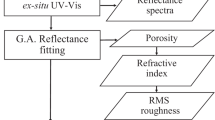Abstract
Optical devices based on photonic crystals are of great interest because they can be efficiently used in laser physics and biosensing. Photonic crystals allow one to control the propagation of electromagnetic waves and to change the emission characteristics of luminophores embedded into photonic structures. One of the most interesting materials for developing one-dimensional photonic crystals is porous silicon. However, an important problem in application of this material is the control of the refractive index of layers by changing their porosity, as well as the refractive index dispersion. In addition, it is important to have the possibility of modeling the optical properties of structures to choose precisely select the fabrication parameters and produce one-dimensional photonic crystals with prescribed properties. In order to solve these problems, we used a mathematical model based on the transfer matrix method, using the Bruggeman model, and on the dispersion of silicon refractive index. We fabricated microcavities by electrochemical etching of silicon, with parameters determined by the proposed model, and measured their reflection spectra. The calculated results showed good agreement with experimental data. The model proposed allowed us to achieve a microcavity Q-factor of 160 in the visible region.
Similar content being viewed by others
References
B. Troia, A. Paolicelli, F. de Leonardis, and V. M. N. Passaro, in Advances in Photonic Crystals, Ed. by V. M. N. Passaro (InTech, Croatia, 2013), p. 241.
D. Threm, Y. Nazirizadeh, and M. Gerken, J. Biophoton. 5, 601 (2012).
C. Pacholski, Sensors (Basel) 13, 4694 (2013).
G. E. Kotkovskiy, Y. A. Kuzishchin, I. L. Martynov, A. A. Chistyakov, and I. Nabiev, Phys. Chem. Chem. Phys. 14, 13890 (2012).
D. Dovzhenko, E. Osipov, I. Martynov, P. Linkov, and A. Chistyakov, Phys. Proc. 73, 126 (2015).
M. Khardani, M. Bouaïcha, and B. Bessaïs, Phys. Status Solidi 4, 1986 (2007).
P. J. Reece, G. Lérondel, W. H. Zheng, and M. Gal, Appl. Phys. Lett. 81, 4895 (2002).
M. A. Green and M. J. Keevers, Prog. Photovolt. 3, 189 (1995).
P. Pirasteh, Y. G. Boucher, J. Charrier, and Y. Dumeige, Phys. Status Solidi 1975, 1971 (2007).
D. S. Dovzhenko, I. Martynov, P. Samokhvalov, and I. Eremin, Proc. SPIE 9126, 91263O (2014).
Author information
Authors and Affiliations
Corresponding author
Additional information
Original Russian Text © D.S. Dovzhenko, I.L. Martynov, I.S. Kryukova, A.A. Chistyakov, I.R. Nabiev, 2017, published in Optika i Spektroskopiya, 2017, Vol. 122, No. 1, pp. 87–90.
Rights and permissions
About this article
Cite this article
Dovzhenko, D.S., Martynov, I.L., Kryukova, I.S. et al. Modeling of the optical properties of porous silicon photonic crystals in the visible spectral range. Opt. Spectrosc. 122, 79–82 (2017). https://doi.org/10.1134/S0030400X17010064
Received:
Published:
Issue Date:
DOI: https://doi.org/10.1134/S0030400X17010064




